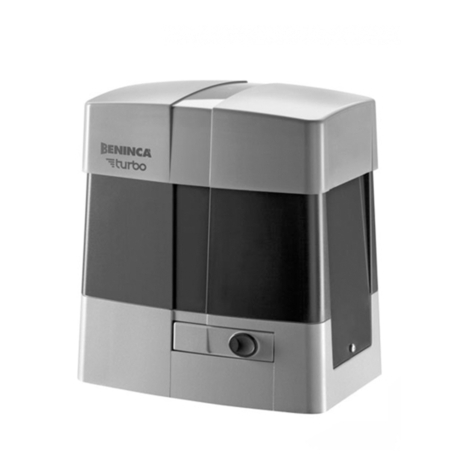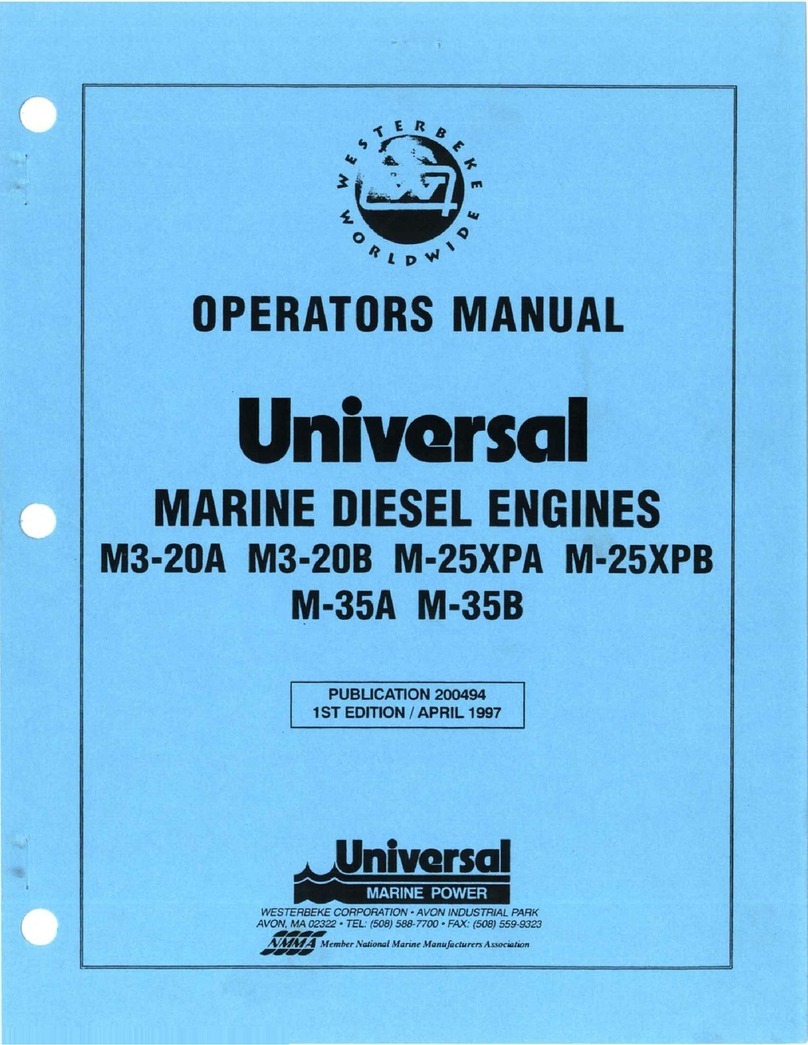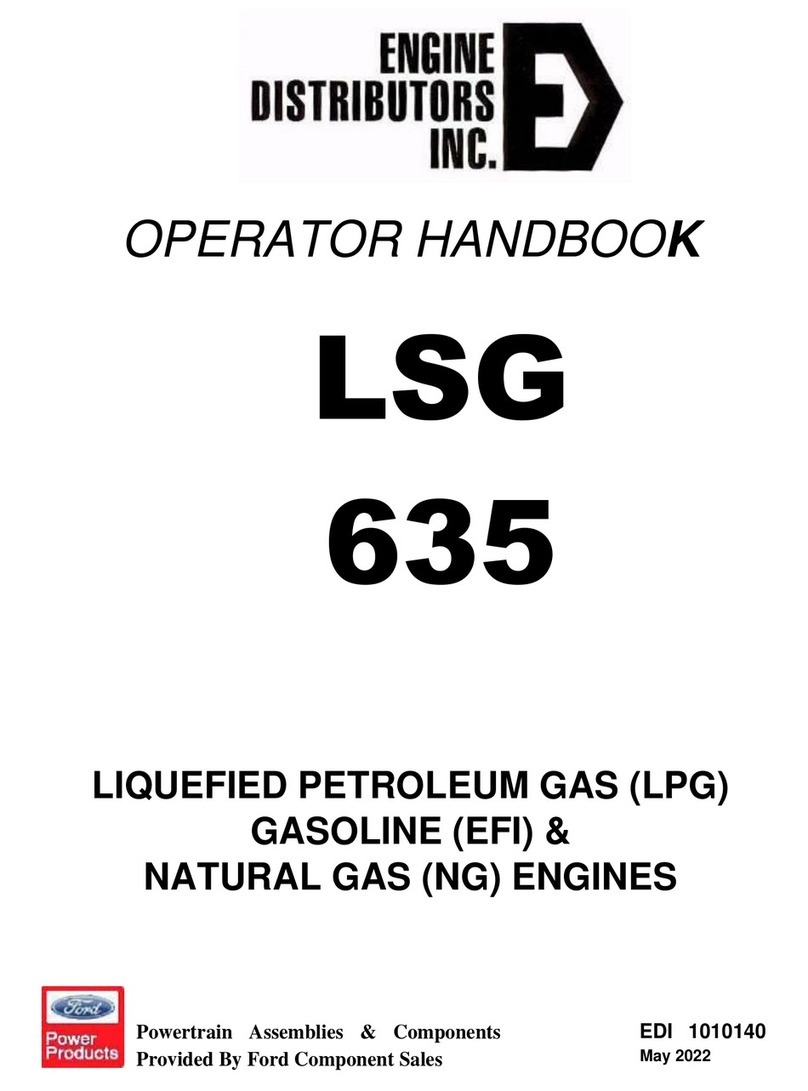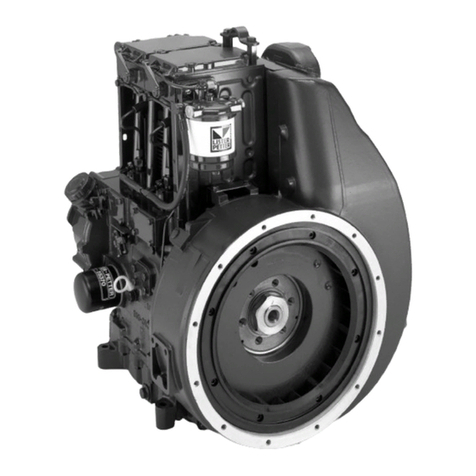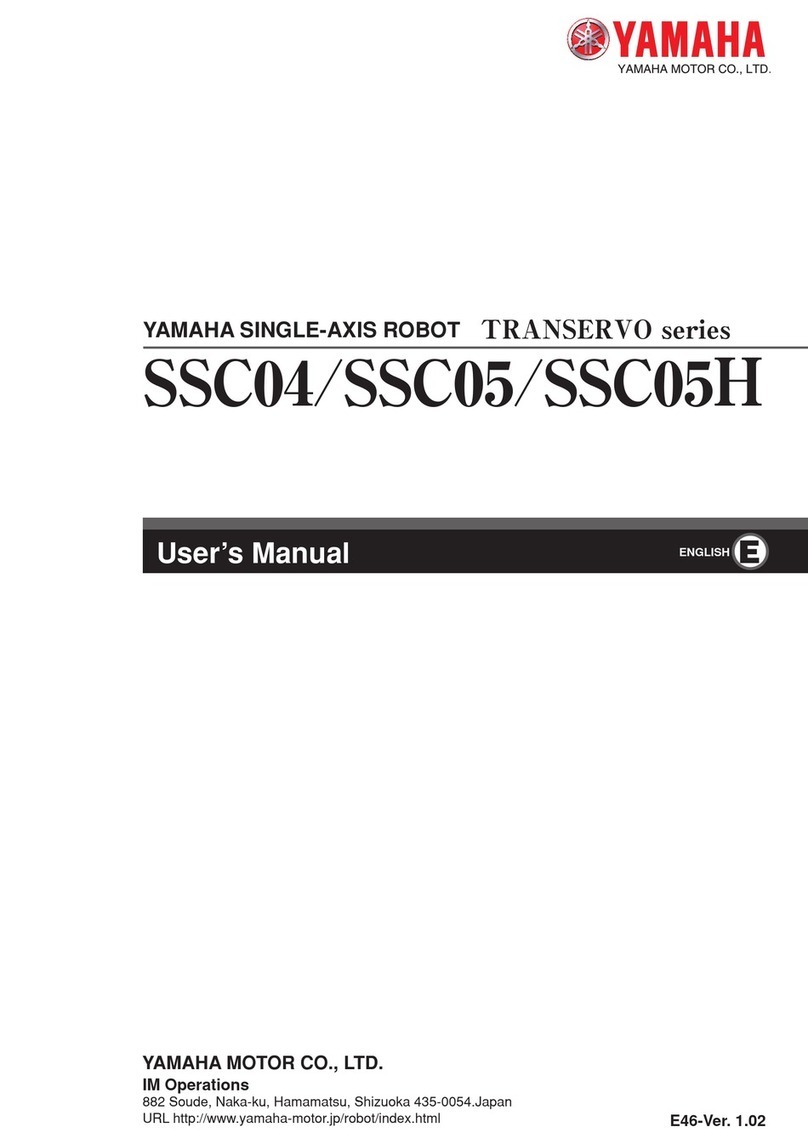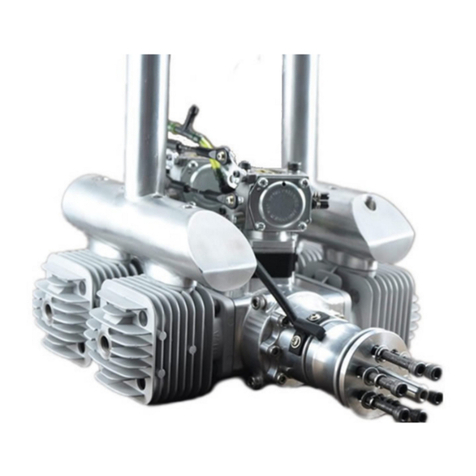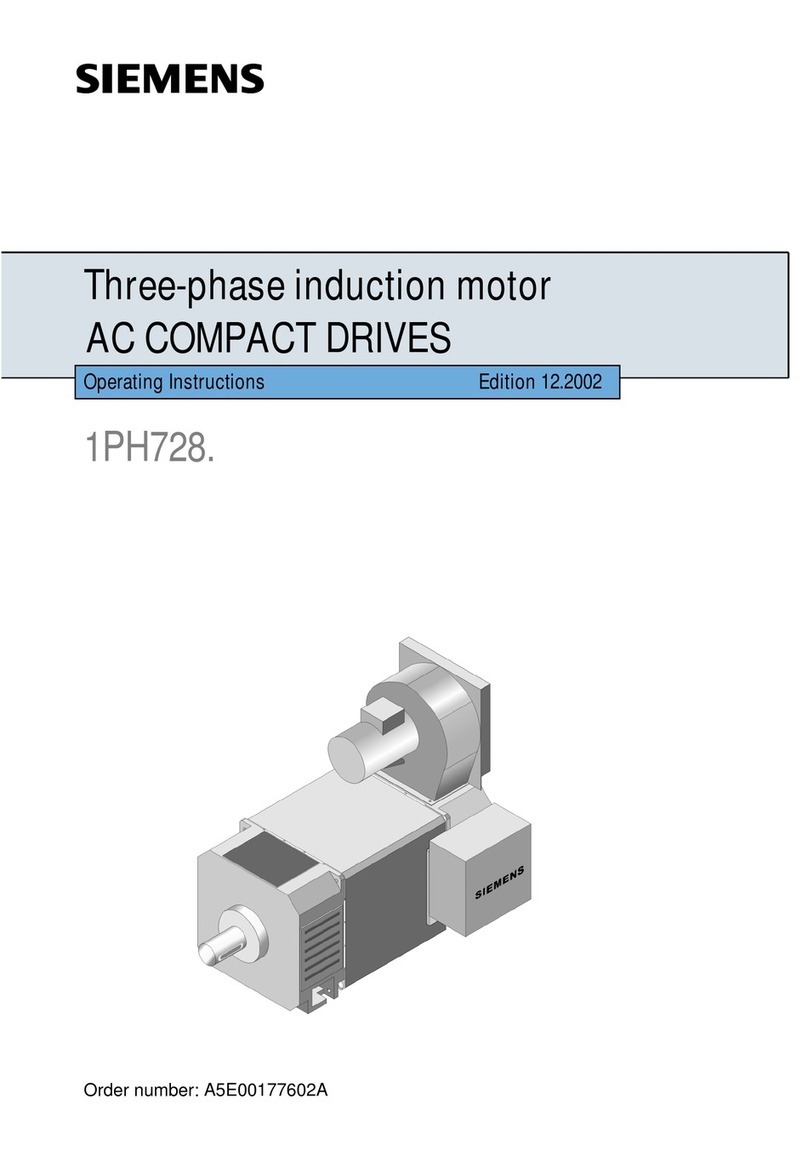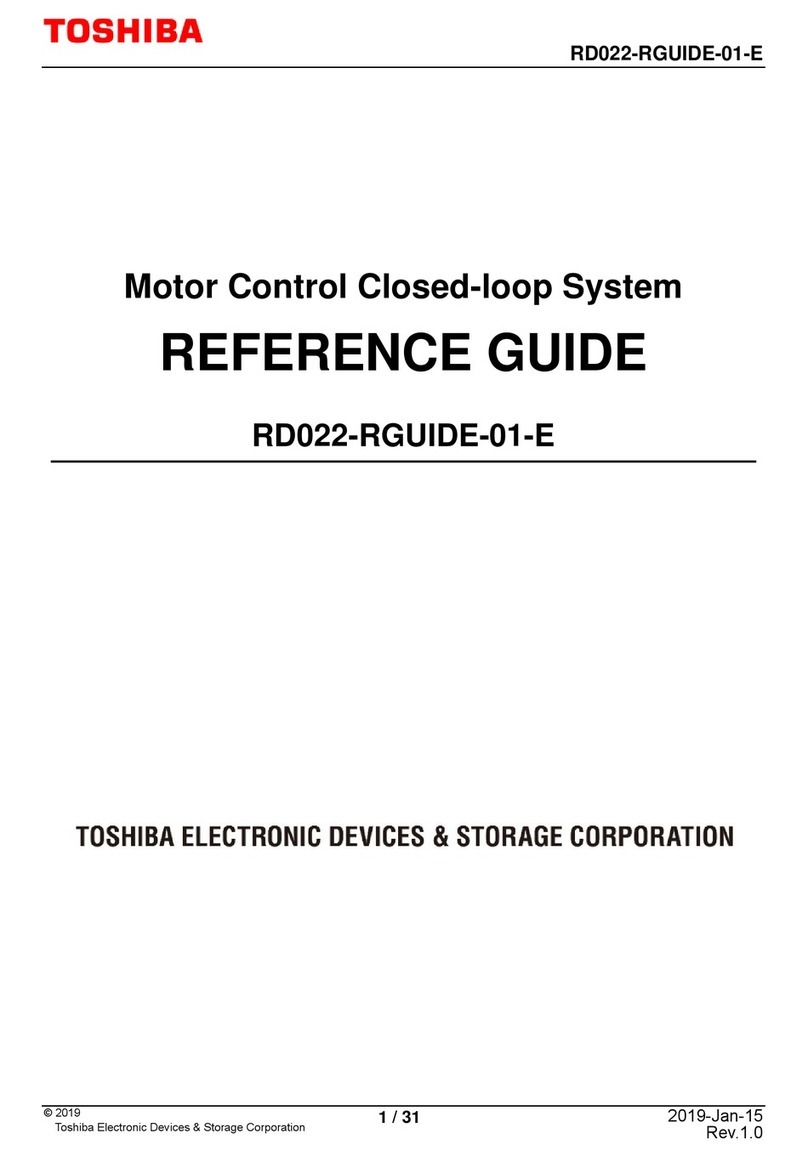Bayliner MCM 7.4L User manual

Important
Information
Removal and
Installation
Engine
Electrical System
Fuel System
Cooling System
Exhaust System
Drives 8
1
2
3
4
5
6
7
9
Power Steering
90-823224--2 796 v
Service Manual Outline
Section 1 - Important Information
A - General Information
B - Maintenance
C - Troubleshooting
Section 2 - Removal and Installation
A - MCM Models - Bravo and Blackhawk Drives
B - MCM Models - Bravo and Blackhawk with
Driveshaft Extension
C - MIE Models - Velvet Drive Transmissions
D - MIE Models - Hurth Transmissions
Section 3 - Engine
A - 454 CID / 7.4L / 502 CID / 8.2L
Section 4 - Electrical Systems
A - Starting System
B - Ignition System
C - Charging System
D - Instrumentation
E - Electrical Kits
F - Wiring Diagrams
Section 5 - Fuel System
A - Fuel Delivery Systems and Fuel Pumps
B - Weber 4 Barrel Carburetor
C - Electronic Fuel Injection
(Throttle Body and Multi-Port Injection)
Section 6 - Cooling System
A - Seawater Cooled Models
B - Closed Cooled Models
Section 7 - Exhaust System
A - General
B - Manifold and Elbows
C - Risers
D - Collectors
Section 8 - Drives
A - Velvet Drive In-Line Transmission
B - Velvet Drive V-Drive Transmission
C - Hurth Down Angle Transmission
D - Hurth V-Drive Transmission
E - Drive Shaft Models/Propeller Shaft
Section 9 - Power Steering
A - Pump

90-823224--2 796 i
Notice
Throughout this publication, “Dangers,” “Warnings”
and “Cautions” are used to alert the mechanic to spe-
cial instructions concerning a particular service or
operation that may be hazardous if performed incor-
rectly or carelessly. Observe them carefully!
These “Safety Alerts” alone cannot eliminate the haz-
ards that they signal. Strict compliance to these spe-
cial instructions when performing the service, plus
“common sense” operation, are major accident pre-
vention measures.
!DANGER
DANGER - Immediate hazards which will result in
severe personal injury or death.
!WARNING
WARNING - Hazards or unsafe practices which
could result in severe personal injury or death.
!CAUTION
CAUTION - Hazards or unsafe practices which
could result in minor personal injury or product
or property damage.
Notice to Users of This
Manual
This service manual has been written and published
by the service department of Mercury Marine to aid
our dealers, mechanics and company service per-
sonnel when servicing the products described here-
in.
It is assumed that these personnel are familiar with
the servicing procedures of these products, of like or
similar products manufactured and marketed by
Mercury Marine, and that they have been trained in
the recommended servicing procedures for these
products which include the use of mechanic’s
common hand tools and the special Mercury
Marine or recommended tools from other suppliers.
We could not possibly know of and advise the service
trade of all conceivable procedures by which a ser-
vice might be performed and of the possible hazards
and/or results of each method. We have not under-
taken any such wide evaluation. Therefore, anyone
who uses a service procedure and/or tool, which is
not recommended by the manufacturer, first
must completely satisfy himself that neither his nor
the product’s safety will be endangered by the ser-
vice procedure selected.
All information, illustrations and specifications con-
tained in this manual are based on the latest product
information available at time of publication.
It should be kept in mind, while working on the prod-
uct, that the electrical system and ignition system are
capable of violent and damaging short circuits or se-
vere electrical shocks. When performing any work
where electrical terminals could possibly be
grounded or touched by the mechanic, the battery
cables should be disconnected at the battery.
Any time the intake or exhaust openings are exposed
during service they should be covered to protect
against accidental entrance of foreign material which
could enter the cylinders and cause extensive inter-
nal damage when the engine is started.
It is important to note that, during any mainte-
nance procedure, replacement fasteners must have
the same measurements and strength as those re-
moved, whether metric or customary. Numbers on
the heads of the metric bolts and on surfaces of met-
ric nuts indicate their strength. Customary bolts use
radial lines for this purpose, while most custom-
ary nuts do not have strength markings. Mismatched
or incorrect fasteners can result in damage or mal-
function, or possible personal injury. Therefore, fas-
teners removed should be saved for re-use in the
same locations whenever possible. Where the fas-
teners are not satisfactory for re-use, care should be
taken to select a replacement that meets the
same specifications as the original.

90-823224--2 796ii
Engine Mechanical
Components
Many of the engine mechanical components are de-
signed for marine applications. Unlike automotive
engines, marine engines are subjected to extended
periods of heavy load and wide-open-throttle opera-
tion and, therefore, require heavy-duty components.
Special marine engine parts have design and man-
ufacturing specifications which are required to pro-
vide long life and dependable performance. Marine
engine parts also must be able to resist the corrosive
action of salt or brackish water that will rust or cor-
rode standard automotive parts within a short period
of time.
Failure to use recommended Quicksilver service re-
placement parts can result in poor engine perform-
ance and/or durability, rapid corrosion of parts sub-
jected to salt water and possibly complete failure of
the engine.
Use of parts other than recommended service re-
placement parts, will void the warranty on those parts
which are damaged as a result of the use of other
than recommended replacement parts.
Replacement Parts
!WARNING
Electrical, ignition and fuel system components
on MerCruiser Engines and Stern Drives are de-
signed and manufactured to comply with U.S.
Coast Guard Rules and Regulations to minimize
risks of fire or explosion.
Use of replacement electrical, ignition or fuel
system components, which do not comply to
these rules and regulations, could result in a fire
or explosion hazard and should be avoided.
When servicing the electrical, ignition and fuel
systems, it is extremely important that all com-
ponents are properly installed and tightened. If
not, any electrical or ignition component open-
ing would permit sparks to ignite fuel va-
pors from fuel system leaks, if they existed.

90-823224--2 796 iii
V-8 Models Covered in This Manual
Gen V Engines
Model Serial Number
Stern Drive Engines
MCM 7.4L Bravo OD830779 to OF800699
MCM 7.4L Bravo Three OD838819 to OF800699
MCM 7.4LX MPI OF595275 to OF801999
MCM 454 Magnum (Carburetor) OD837587 to OF801999
MCM 454 Magnum EFI, EFI/MP and MPI OF111570 to OF802349
MCM 502 Magnum (Carburetor) OD831432 to OF114528
MCM 502 Magnum EFI, EFI/MP, MPI OD840650 to OF802599
Inboard Engines
MIE 7.4L (Carburetor) OD840300 to OF820141
MIE 7.4L EFI/MP and MPI OF490697 to OF820103
MIE 8.2L (Carburetor) OD857200 to OF819619
Ski Engines
MIE 454 Magnum EFI, EFI/MP and MPI Tournament
Ski
OF215800 to OF820099
Gen VI Engines
Model Serial Number
Stern Drive Engines
MCM Bravo 7.4L (Carburetor) OF800700 and above
MCM 7.4LX EFI OF820000 and above
MCM 7.4LX MPI OF802000 and above
MCM 454 Magnum (Carburetor) OF801700 and Above
MCM 454 MPI OF802350 and above
MCM 502 MPI OF802600 and above
Inboard Engines
MIE 7.4L (Carburetor) OF820142 and above
MIE 7.4L EFI OF874815 and above
MIE 7.4L MPI OF820104 and above
MIE 8.2L MPI OF775694 and OF775695
MIE 8.2L MPI OF819620 and above

A
1
IMPORTANT INFORMATION
GENERAL INFORMATION

1A-0 - GENERAL INFORMATION 90-823224--2 796
Table of Contents
Page
Introduction 1A-1. . . . . . . . . . . . . . . . . . . . . . . . . . . . . .
How to Use This Manual 1A-1. . . . . . . . . . . . . . . . . .
Page Numbering 1A-1. . . . . . . . . . . . . . . . . . . . . .
How To Read Parts Manual 1A-2. . . . . . . . . . . . . . . .
Directional References 1A-3. . . . . . . . . . . . . . . . . . . .
Engine Rotation 1A-3. . . . . . . . . . . . . . . . . . . . . . . . . .
Engine Serial Number Locations 1A-4. . . . . . . . . . .
Propeller Information 1A-4. . . . . . . . . . . . . . . . . . . . .
Water Testing New Engines 1A-4. . . . . . . . . . . . . . .
Boat and Engine Performance 1A-5. . . . . . . . . . . . .
Boat Bottom 1A-5. . . . . . . . . . . . . . . . . . . . . . . . . .
Marine Fouling 1A-6. . . . . . . . . . . . . . . . . . . . . . . .
Weight Distribution 1A-6. . . . . . . . . . . . . . . . . . . .
Water in Boat 1A-7. . . . . . . . . . . . . . . . . . . . . . . . .
Elevation and Climate 1A-7. . . . . . . . . . . . . . . . . .

GENERAL INFORMATION - 1A-190-823224--2 796
Introduction
This comprehensive overhaul and repair manual is
designed as a service guide for the models previous-
ly listed. It provides specific information, including
procedures for disassembly, inspection, assembly
and adjustment to enable dealers and service me-
chanics to repair and tune these engines.
Before attempting repairs or tune-up, it is suggested
that the procedure first be read through to gain knowl-
edge of the methods and tools used and the cautions
and warnings required for safety.
How to Use This Manual
This manual is divided into sections which represent
major components and systems.
Some sections are further divided into parts which
more fully describe the component.
Sections and section parts are listed on the “Service
Manual Outline” page following “V-8 Models Covered
in This Manual” page.
Page Numbering
Two number groups appear at the bottom of each
page. Following is an example and description.
72426

1A-2 - GENERAL INFORMATION 90-823224--2 796
How To Read Parts Manual
841-81631 1 CYLINDER BLOCK ASSEMBLY 1
N.S.S. 2 PLUG, expansion (1-1/4”) (GM #3738306) 2
22-87238 3 DRAIN COCK, cylinder block 2
19-34270 4 PLUG, expansion - cylinder block (1-5/8” Diameter) 8
17-35465 5 PIN, dowel - block to head (5/16” Diameter) 4
22-72640 6 PLUG, expansion - camshaft bearing hole 1
23-85674 7 BEARING UNIT, camshaft (set) 1
72638 8 LIFTER, hydraulic valve 16
431-5943 9 CAMSHAFT 1
35378 10 CHAIN, camshaft timing 1
43-35338 11 SPROCKET, camshaft timing 1
43-48338 12 SPROCKET, crankshaft timing 1
10-34505 13 BOLT, camshaft timing sprockets (3/4”) 3
12-39167 14 WASHER, camshaft timing sprocket bolt 3
841-8163 Cylinder Block Assembly includes only standard pistons,
piston rings, crankshaft bearings and camshaft bearings.
PART NO.
REF.
NO. DESCRIPTION QUAN.
a
A. Part Number: For part ordering - Note N.S.S. for Reference Number 2, Plug, expansion - that means Not Sold Sepa-
rately by Mercury Marine, however, in this case, the G.M. Part Number (for the plug) is given in the Description Column.
B. Reference Number: For part Shown on exploded parts view.
C. Description: This is the most important column because it gives:
1) Description of Part: Ref. No. 1 is a Cylinder Block Assembly, No. 9 is a Camshaft, etc.
2) What parts are included with a certain part: Notice how the Description of Part, for Ref. Nos. 1 and 8 thru 14, are
at the left side of the column. Description of Part for Ref. Nos. 2 thru 7 are indented under “Cylinder Block Assembly”.
If Ref. No. 1 (Cylinder Block Assembly) was ordered, all indented parts (Ref. Nos 2thru 7) would come with the part.
Ref. Nos. 8 thru 14 would not come with Ref. No. 1 and would have to be ordered separately. If 2 Cylinder Blocks
were listed, both cylinder blocks would come with the indented parts. In some cases, an indented part will have anoth
er part indented under it. The second indented part will come with the first indented part.
3) Serial number break: If serial number information is listed, check product serial number to ensure that correct part
is ordered.4) Special information: Many times special information will be shown after description such as; L.H. Rota
tion, R. H. Rotation, Filter up, Filter Down, etc. This will help in selecting the correct part.
D. Quantity: Quantity that has to be ordered.
E. Special Information Block: Additional information, part numbers for gasket sets, etc.
M0033-D8
b
cd
e
CYLINDER BLOCK AND CAMSHAFT

GENERAL INFORMATION - 1A-390-823224--2 796
Directional References
Front of boat is bow; rear is stern. Starboard side is
right side; port side is left side. In this maintenance
manual, all directional references are given as they
appear when viewing boat from stern looking toward
bow.
72000
STARBOARD
(RIGHT)
PORT
(LEFT)
FORE or BOW
(FRONT)
AFT or STERN
(REAR)
Engine Rotation
Engine rotation is determined by observing flywheel
rotation from the rear (stern end) of the engine look-
ing forward (toward water pump end). Propeller rota-
tion is not necessarily the same as engine rotation.
When ordering replacement engine, short blocks or
parts for engine, be certain to check engine rotation.
Do not rely on propeller rotation in determining en-
gine rotation.
72001
Standard Left-Hand Rotation

1A-4 - GENERAL INFORMATION 90-823224--2 796
Engine Serial Number
Locations
72923
b
a
Stern Drive (MCM)
a-SerialNumberPlate
b - Starter Motor
72924
b
a
Inboard (MIE)
a-SerialNumberPlate
b - Starter Motor
Propeller Information
Refer to the “Propeller” section in appropriate Mer-
Cruiser Stern Drive Service Manual, or order publica-
tion 90-86144-92, “Everything you need to know
about propellers.”
Changing diameter, pitch or coupling of a propeller
will affect engine RPM and boat performance. The
blade configuration also will affect performance. Two
like propellers, same pitch and diameter, from two dif-
ferent manufacturers also will perform differently.
It is the responsibility of the boat manufacturer and/or
selling dealer to equip the boat with the correct pro-
peller to allow the engine to operate within its speci-
fied RPM range at wide-open-throttle (W.O.T.).
Because of the many variables of boat design and
operation, only testing will determine the best propel-
ler for the particular application.
To test for correct propeller, operate boat (with an av-
erage load onboard) at W.O.T. and check RPM with
an accurate tachometer. Engine RPM should be near
top of the specified range so that, under heavy load,
engine speed will not fall below specifications.
If engine exceeds the specified RPM, an increase in
pitch and/or diameter is required.
If engine is below rated RPM, a decrease in pitch
and/or diameter is required.
Normally, a change of approximately 150 RPM will be
achieved for each single inch of pitch change of a
propeller.
!CAUTION
If a propeller is installed that does not allow en-
gine RPM to reach the specified full-throttle RPM
range, the engine will “labor” and will not pro-
duce full power. Operation under this condition
will cause excessive fuel consumption, engine
overheating and possible piston damage (due to
detonation). On the other hand, installation of a
propeller, that allows engine to run above the
specified RPM limit, will cause excessive wear on
internal engine parts which will lead to premature
engine failure.
Water Testing New Engines
Use care during the first 20 hours of operation on new
MerCruiser engines or possible engine failure may
occur. If a new engine has to be water-tested at full
throttle before the break-in period is complete, follow
this procedure.

GENERAL INFORMATION - 1A-590-823224--2 796
1. Start engine and run at idle RPM until normal op-
erating temperature is reached.
2. Run boat up on plane.
3. Advance engine RPM (in 200 RPM increments)
until engine reaches its maximum rated RPM.
IMPORTANT: Do not run at maximum RPM for
more than 2 minutes.
Boat and Engine
Performance
Boat Bottom
For maximum speed, a boat bottom should be as flat
as possible in a fore-aft direction (longitudinally) for
approximately the last 5 ft. (1.5 m).
72002
a
a - Critical Bottom Area
For best speed and minimum spray, the corner be-
tween the bottom and the transom should be sharp.
72003
b
c
a
a - Flat
b - Sharp Corner
c - Transom
The bottom is referred to as having a “hook” if it is
concave in the fore-and-aft direction. A hook causes
more lift on the bottom near the transom and forces
the bow to drop. This increases wetted surface and
reduces boat speed. A hook, however, aids in planing
and reduces any porpoising (rhythmical bouncing)
tendency. A slight hook is often built in by the man-
ufacturer. A hook also can be caused by incorrect
trailering or storing the boat with support directly un-
der the transom.
72004
b
a
a - Hook
b - Transom

1A-6 - GENERAL INFORMATION 90-823224--2 796
A “rocker” is the reverse of a hook. The bottom is con-
vex or bulged in the fore-and-aft direction. It can
cause the boat to porpoise.
72005
a
b
a - Rocker
b - Transom
Any hook, rocker or surface roughness on the bot-
tom, particularly in the all-important center-aft portion
will have a negative effect on speed, often several
miles per hour on a fast boat.
Marine Fouling
Fouling is an unwanted build-up (usually animal-veg-
etable-derived) occurring on the boat’s bottom and
drive unit. Fouling adds up to drag, which reduces
boat performance. In fresh water, fouling results from
dirt, vegetable matter, algae or slime, chemicals,
minerals and other pollutants. In salt water, bar-
nacles, moss and other marine growth often produce
dramatic build-up of material quickly. Therefore, it is
important to keep the hull as clean as possible in all
water conditions to maximize boat performance.
Antifouling paint, if required, may be applied to boat
hull observing the following precautions.
IMPORTANT: DO NOT paint anodes or MerCa-
thode System reference electrode and anode, as
this will render them ineffective as galvanic cor-
rosion inhibitors.
!CAUTION
Avoid corrosion damage. Do not apply antifoul-
ing paint to MerCruiser drive unit or transom as-
sembly.
IMPORTANT: If antifouling protection is required,
Tri-Butyl-Tin-Adipate (TBTA) base antifouling
paints are recommended on MerCruiser boating
applications. In areas where Tri-Butyl-Tin-Adi-
pate base paints are prohibited by law, copper
base paints can be used on boat hull and boat
transom. Corrosion damage that results from the
improper application of antifouling paint will not
be covered by the limited warranty. Observe the
following:
Avoid an electrical interconnection between the
MerCruiser Product, Anodic Blocks, or MerCa-
thode System and the paint by allowing a mini-
mum of 1 in. (26mm) UNPAINTED area on tran-
som of the boat around these items.
71176
b
a
a - Antifouling Paint
b - MINIMUM 1 Inch (26 mm) UNPAINTED Area
Weight Distribution
Weight distribution is extremely important; it affects
a boat’s running angle or attitude. For best top speed,
all movable weight - cargo and passengers - should
be as far aft as possible to allow the bow to come up
to a more efficient angle (3 to 5 degrees). On the neg-
ative side of this approach is the problem that, as
weight is moved aft, some boats will begin an unac-
ceptable porpoise.
Secondly, as weight is moved aft, getting on plane
becomes more difficult.
Finally, the ride in choppy water becomes more un-
comfortable as the weight goes aft. With these fac-
tors in mind, each boater should seek out what
weight locations best suit his/her needs.

GENERAL INFORMATION - 1A-790-823224--2 796
Weight and passenger loading placed well forward
increases the “wetted area” of the boat bottom and,
in some cases, virtually destroys the good perform-
ance and handling characteristics of the boat. Opera-
tion in this configuration can produce an extremely
wet ride, from wind-blown spray, and could even be
unsafe in certain weather conditions or where bow
steering may occur.
Weight distribution is not confined strictly to fore and
aft locations, but also applies to lateral weight distri-
bution. Uneven weight concentration to port or star-
board of the longitudinal centerline can produce a se-
vere listing attitude that can adversely affect the
boat’s performance, handling ability and riding com-
fort. In extreme rough water conditions, the safety of
the boat and passengers may be in jeopardy.
Water in Boat
When a boat loses performance, check bilge for wa-
ter. Water can add considerable weight to the boat,
thereby decreasing the performance and handling.
Make certain that all drain passages are open for
complete draining.
Elevation and Climate
Elevation has a very noticeable effect on the
wide-open- throttle power of an engine. Since air
(containing oxygen) gets thinner as elevation in-
creases, the engine begins to starve for air. Humidity,
barometric pressure and temperature do have a no-
ticeable effect on the density of air. Heat and humidity
thin the air. This phenomenon can become particu-
larly annoying when an engine is propped out on a
cool dry day in spring and later, on a hot, sultry day
in August, doesn’t have its old zip.
Although some performance can be regained by
dropping to a lower pitch propeller, the basic problem
still exists. The propeller is too large in diameter for
the reduced power output. The experienced marine
dealer or a Quicksilver Propeller Repair Station can
determine how much diameter to remove from a low-
er-pitch propeller for specific high-elevation loca-
tions. In some cases, a gear-ratio change to the drive
unit to more reduction is possible and very beneficial.
It is a known fact that weather conditions exert a pro-
found effect on power output of internal combustion
engines. Therefore, established horsepower ratings
refer to the power that the engine will produce at its
rated RPM under a specific combination of weather
conditions.

THIS PAGE IS INTENTIONALLY BLANK TO
ALLOW FOR CORRECTIONS OR ADDITIONS
AT A LATER DATE
1A-8 - GENERAL INFORMATION 90-823224--2 796

B
1
72526
IMPORTANT INFORMATION
MAINTENANCE

1B-0 - MAINTENANCE 90-823224--2 796
Table of Contents
Page
Maintenance Schedule 1B-1. . . . . . . . . . . . . . . . . . . .
Maintenance Intervals 1B-1. . . . . . . . . . . . . . . . . .
To Be Done by Dealer 1B-2. . . . . . . . . . . . . . . . . .
Tune-Up Specifications 1B-4. . . . . . . . . . . . . . . . . . .
MCM (Stern Drive) 1B-4. . . . . . . . . . . . . . . . . . . . .
MIE (Inboard) 1B-5. . . . . . . . . . . . . . . . . . . . . . . . .
Fluid Capacities 1B-6. . . . . . . . . . . . . . . . . . . . . . . . . .
All Models 1B-7. . . . . . . . . . . . . . . . . . . . . . . . . . . . . . .
20-Hour Break-In Period 1B-7. . . . . . . . . . . . . . . .
End of First Season Checkup 1B-7. . . . . . . . . . .
Fuel Specifications 1B-8. . . . . . . . . . . . . . . . . . . . . . .
Fuel 1B-8. . . . . . . . . . . . . . . . . . . . . . . . . . . . . . . . .
Crankcase Oil 1B-9. . . . . . . . . . . . . . . . . . . . . . . . .
Power Steering Fluid 1B-10. . . . . . . . . . . . . . . . . .
Transmission Fluid 1B-10. . . . . . . . . . . . . . . . . . . .
Coolant for Closed Cooling System 1B-10. . . . .
Maintaining Crankcase Oil Level 1B-10. . . . . . . . . .
Overfilled Engine Crankcase 1B-10. . . . . . . . . . .
Checking Engine Oil Level/Filling 1B-10. . . . . . .
Changing Oil and Filter 1B-10. . . . . . . . . . . . . . . . . . .
Maintaining Power Steering Pump
Fluid Level 1B-11. . . . . . . . . . . . . . . . . . . . . . . . . . . . .
With Engine Warm 1B-11. . . . . . . . . . . . . . . . . . . .
With Engine Cold 1B-11. . . . . . . . . . . . . . . . . . . . .
Filling and Bleeding Power Steering System 1B-12
Maintaining Closed Cooling Coolant Level 1B-13. .
Flushing Cooling System 1B-13. . . . . . . . . . . . . . . . .
MCM (Stern Drive) 1B-13. . . . . . . . . . . . . . . . . . . .
MIE (Inboard) 1B-15. . . . . . . . . . . . . . . . . . . . . . . .
Maintaining Transmission Fluid Level 1B-15. . . . . .
Lubrication 1B-16. . . . . . . . . . . . . . . . . . . . . . . . . . . . .
Throttle Cable 1B-16. . . . . . . . . . . . . . . . . . . . . . . .
Shift Cable 1B-17. . . . . . . . . . . . . . . . . . . . . . . . . . .
Engine Coupler/U-Joint Shaft Splines 1B-18. . .
Drive Shaft Extension Models 1B-18. . . . . . . . . .
Starter Motor 1B-19. . . . . . . . . . . . . . . . . . . . . . . . .
Cold Weather or Extended Storage 1B-19. . . . . . . .
Precautions 1B-19. . . . . . . . . . . . . . . . . . . . . . . . . .
Layup 1B-20. . . . . . . . . . . . . . . . . . . . . . . . . . . . . . .
Draining Instructions 1B-22. . . . . . . . . . . . . . . . . .
Recommissioning 1B-34. . . . . . . . . . . . . . . . . . . . .

MAINTENANCE - 1B-190-823224--2 796
Maintenance Schedule
Maintenance Intervals
Maintenance intervals and the tasks to be performed, as shown in this current schedule, or as found in a pre-
viously printed schedules, are generally based on an average boating application and environment. However,
individual operating habits and personal maintenance preferences can have an impact on the suggested inter-
vals. In consideration of these factors, MerCruiser has adjusted some maintenance intervals and corresponding
tasks to be performed. In some cases, this may allow for more individual tasks to be performed in a single visit
to the serving dealer, rather than multiple visits. Therefore, it is very important that the boat owner and servicing
dealer discuss the current Maintenance Schedule and develop appropriate maintenance intervals to coincide
with the individual operating habits, environment, and maintenance requirements.
Always disconnect battery cables from battery BEFORE working around electrical systems components to pre-
vent injury to yourself and damage to electrical system should a wire be accidentally shorted.
SCHEDULED MAINTENANCE THAT CAN BE PERFORMED BY OWNER/OPERATOR
NOTE: Only perform maintenance which applies to your particular power package.
Task Interval
Engine Crankcase Oil - Check level
W kl
Closed Cooling Coolant - Check level
W kl
Power Steering Fluid - Check level
W kl
Stern Drive Unit Oil - Check level
W kl
Battery - Check level and inspect for damage
Weekly
Fuel Pump Sight Tube (If Equipped) - Check that no
fuel is present
W
ee
kl
y
Power Trim Pump Oil - Check level
Anodes - Inspect for erosion
Gear Housing Water Pickups - Check for marine
growth or debris
Drive Belt(s) - Inspect condition and check tension Every 100 hours of operation or 120 days.
Whichever occurs first.
Propeller Shaft - Lubricate Saltwater Use: Every 50 hours of operation or 60
days, Whichever occurs first.
Power Package - Exterior Surfaces - Spray with rust
preventative
days
,
Whichever
occurs
first
.
Freshwater Use: Every 100 hours of operation or
120 days, Whichever occurs first.
Power Package Exterior Surfaces - Clean and paint Once a year
Cooling System - Flush seawater section Saltwater Use: After every use.

1B-2 - MAINTENANCE 90-823224--2 796
Maintenance Schedule (Continued)
To Be Done by Dealer
NOTE: Only perform maintenance which applies to your particular power package.
Task Interval
Seawater Pickup Pump - Disassemble and inspect Whenever insufficient seawater flow is suspected.
(If operating temperature exceeds normal range.)
Crankcase Oil and Filter Change
E d f fi b i
Ignition system - Clean and Inspect condition.
E d f fi b i
Flame Arrestor and Crankcase Ventilation Hose -
Clean and Inspect.
E d f fi b i
Positive Crankcase Ventilation (PCV) Valve (If So
Equipped) - Change
E d f fi b i
Stern Drive unit Oil - Change
E d f fi b i
Gimbal Ring Clamping Screws - Retorque to 40 ft.
lb. (54 N·m)
E d f fi b i
Rear Engine Mounts - Check torque to 30-40 ft. lb.
(47-54 N·m)
E d f fi b i
Gimbal Bearing - Lubricate
E d f fi b i
Cooling System - Clean and Inspect
E d f fi b i
Engine Alignment - Check
E d f fi b i
Engine Coupling Universal Joint Shaft Splines -
Lubricate
End of first boating season
and thereafter,
every100 hours of operation
Steering System - Lubricate and inspect for loose,
damage or missing parts.
every100
h
ours o
f
operat
i
on
or once yearly, whichever
occurs first.
Electrical System - Check for loose or damaged
wiring.
occurs
first
.
Cooling System Hoses and Clamps - Inspect for
damage and deterioration. Check Clamps for
tightness.
Closed Cooling System Pressure Cap - Clean,
inspect and test .
Continuity Circuit - Check components for loose
connections, broken or frayed wires.
Shift and Throttle Cable and Linkage - Lubricate
and inspect for loose, damaged or missing parts
Engine Exhaust System - Inspect externally for
damage, deterioration and restrictions. Check for
tightness.
Ignition System - Check Timing and adjust as
needed.

MAINTENANCE - 1B-390-823224--2 796
Maintenance Schedule (Continued)
To Be Done by Dealer
NOTE: Only perform maintenance which applies to your particular power package.
Task Interval
Steering Head and Remote Control - Inspect and
Lubricate. End of first boating season and thereafter, every
100 hours of operation or once yearly whichever
Carburetor (If So Equipped) - Inspect and adjust. 100 hours of operation or once yearly, whichever
occu
r
s
fir
s
t.
Throttle Body (Fuel Injection Models) - Inspect
occurs
first
.
Fuel Filters - Replace
OY
Quicksilver Mercathode System - Test output.
OY
Closed Cooling Coolant - Test for Alkalinity Once a Year
Heat Exchanger - Clean seawater section.
Drive Unit Bellows and Clamps - Inspect
Universal Joint Cross Bearings- Inspect
End of first boating season and thereafter, every
200 hours of operation or once yearly, whichever
occurs first.
Closed Cooling Coolant - Replace Every Two Years

1B-4 - MAINTENANCE 90-823224--2 796
Tune-Up Specifications
MCM (Stern Drive)
Model MCM 7.4L
MCM 7.4L
PT Bravo
Three
MCM 454
Magnum
MCM 454
EFI
MCM 502
Magnum
MCM 502
EFI
Magnum
Propshaft Ratings
HP (KW)300 (224) 300 (224) 350 (261) 385 (287) 390 (291) 415 (309)
Number of Cylinders V-8
Displacement 454 C.I.D (7.4L) 502 C.I.D. (8.2L)
Bore/Stroke In. (mm) 4.25x4.00 (108x101.6) 4.47 x 4.00
(113.5 x 101.6)
Compression Ratio 8.0:1 8.6:1
Compression Pressure 150 PSI (1034 kPa)
Idle RPM
(in Forward Gear) 650 600 650 600
Max. RPM (at W.O.T.) 4200-4600 4600-5000
Oil Pressure
(at 2000 RPM) 30-70 PSI (207-483 kPa)
Min. Oil Pressure
(at Idle) 4 PSI (28 kPa)
Fuel Pump Pressure
(at 1800 RPM) 3-7 PSI (21-48 kPa)
Fuel Rail Pressure
(Running) (E.F.I. Only)
37 PSI
(255 kPa)
37 PSI
(255 kPa)
Electrical System 12 V Negative (–) Ground
Min. Battery
Requirements
450 cca
575 mca
90A/h
650 cca,
825 mca,
or 150A/h
550 cca,
700 mca or
120A/h
650 cca,
825 mca,
or 150A/h
Firing Order 1-8-4-3-6-5-7-2
Spark Plug Type AC MR43T/Champion RV15YC4/NGK BR6FS
Spark Plug Gap .035 in (0.9 mm)
Timing (at Idle RPM) 8 Degrees BTDC
Preliminary Idle Mixture 1 1/4 Turns 1 1/4 Turns
Thermostat 143°F
(62°C)
160°F
(71°C)
143°F
(62°C)
160°F
(71°C)
This manual suits for next models
5
Table of contents
Popular Engine manuals by other brands
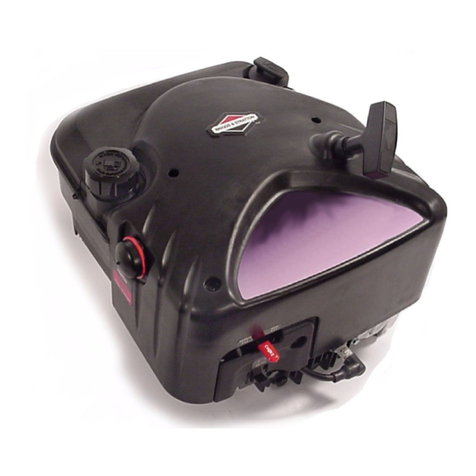
Briggs & Stratton
Briggs & Stratton PowerBuilt Snow 120000 Series Operating & maintenance instructions

LianDa
LianDa NK1-R manual
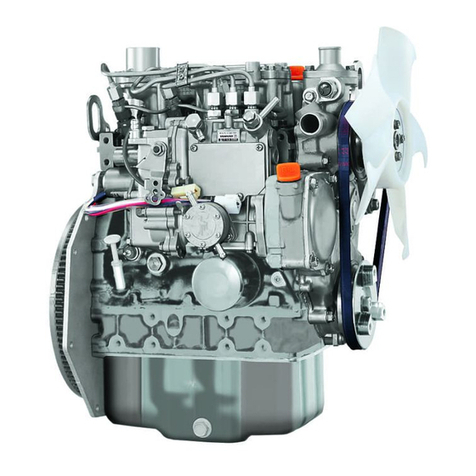
Yanmar
Yanmar 3TNM68 Service manual
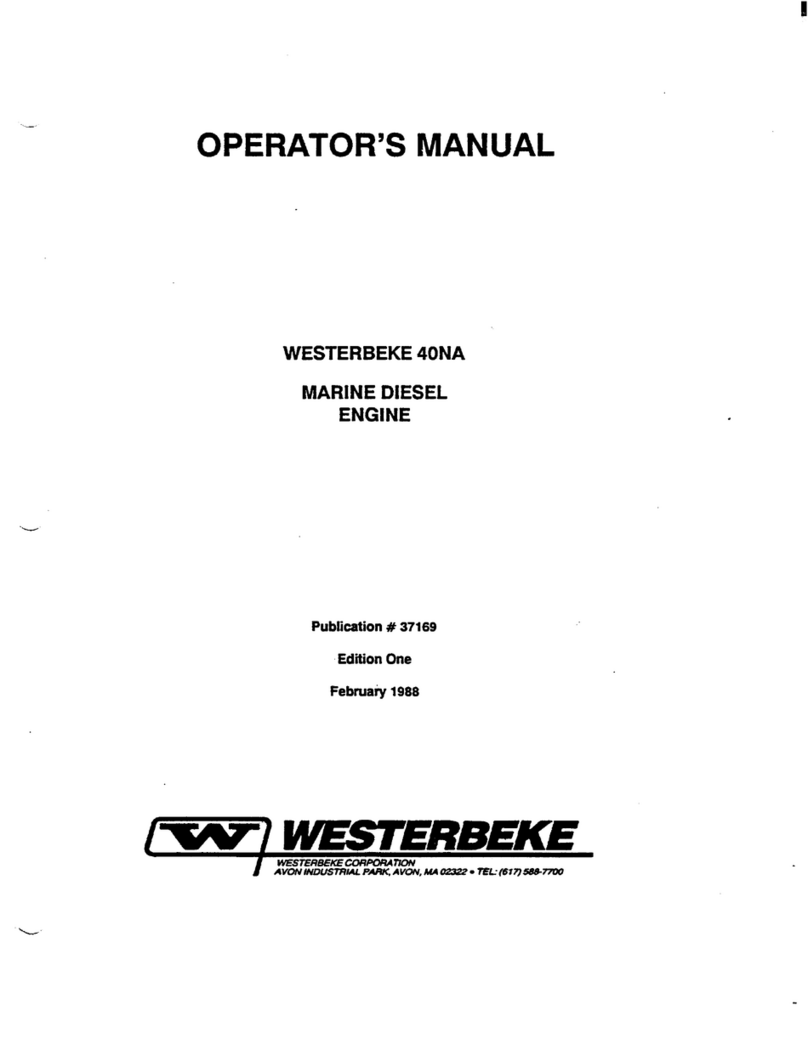
Westerbeke
Westerbeke 40NA Operator's manual
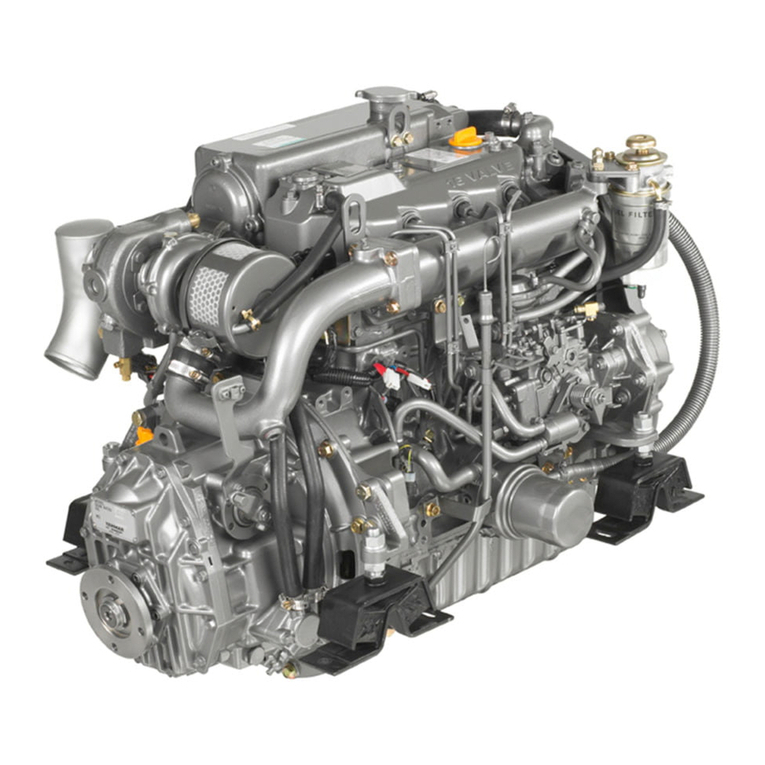
Yanmar
Yanmar 4JHE Service manual
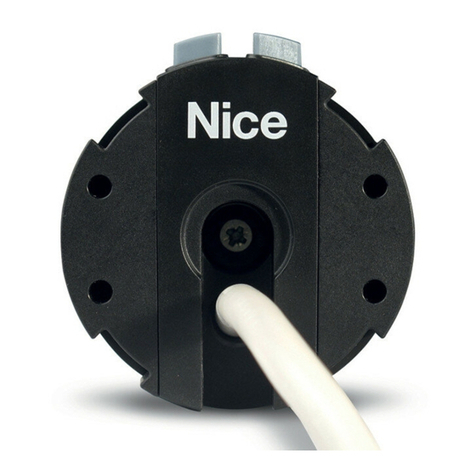
Nice
Nice Era-Era Zero Series Instructions and warnings for installation and use
